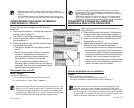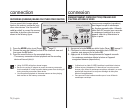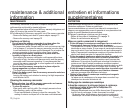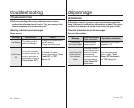
80_English French_80
maintenance & additional
information
Using your memory camcorder abroad
Each country or region has its own electric and color systems.
Before using your memory camcorder abroad, check the
following items.
Power sources
The provided AC adapter features automatic voltage selection in
the AC range from 100 V to 240 V. You can use your camcorder in
any countries/regions using the AC power adaptor supplied with
your camcorder within the AC 100 V to 240 V, 50/60 Hz range.
Use a commercially available AC plug adaptor, if necessary,
depending on the design of the wall outlet.
About TV color systems
Your camcorder is an NTSC-system-based camcorder. If you want
to view your recordings on a TV or to copy it to an external device,
it must be an NTSC-system-based TV or an external device having
the appropriate Audio/Video jacks. Otherwise, you may need to use
a separate video format transcoder (NTSC-PAL format converter).
•
•
•
•
To clean the LCD monitor
Wipe gently with a soft dry cloth. Be careful not to damage the monitor.
To clean the lens
Use an optional air blower to blow out dirt and other small object.
Do not wipe the lens with cloth or your fi ngers.
If necessary, wipe gently with lens cleaning paper.
- Mold may form if the lens is left dirty.
- If the lens looks dimmer, turn off the memory camcorder and
leave it for about 1 hour.
ADDITIONAL INFORMATION
•
•
entretien et informations
supplémentaires
Utilisation du caméscope numérique à l'étranger
Chaque pays ou région possède son propre système électrique
et son codage couleur.
Avant d’utiliser votre caméscope à l’étranger, vérifi ez les points suivants.
Sources d'alimentation
L'adaptateur CA est équipé d'un dispositif de sélection automatique
de tension variant entre 100 Vca a 240 Vca. L'adaptateur CA
compris vous permet d'utiliser votre caméscope dans la gamme CA
située entre 100 V et 240 V, 50/60 Hz, dans tous les pays ou toutes
les régions.Utilisez si nécessaire un raccord de prise CA acheté
dans le commerce selon la forme des prises murales locales.
À propos des systèmes de téléviseurs couleur
Votre caméscope est conforme au système NTSC (National
Television System Committee). Si vous souhaitez visionner
vos enregistrements sur un téléviseur ou les copier vers un
périphérique, ces derniers doivent être conformes au système
NTSC et doivent posséder les prises audio/vidéo appropriées.
Si tel n’est pas le cas, vous devrez peut-être utiliser une carte de
transcodage vidéo séparée (convertisseur de format NTSC-PAL).
•
•
•
•
Pour nettoyer l'écran ACL
Nettoyez délicatement avec un chiffon doux et sec. Prenez garde à ne
pas endommager l'écran.
Pour nettoyer l'objectif
Utilisez un souffl eur d'air (disponible en option) pour éliminer la
saleté et autres petits dépôts. N’essuyez pas l’objectif avec un
chiffon ou avec vos doigts.
Si nécessaire, utilisez un papier spécial pour le nettoyer.
- Un objectif sale encourage la formation de moisissure.
- Si l’objectif semble sombre, éteignez le caméscope numérique
et attendez pendant une heure environ.
INFORMATIONS SUPPLÉMENTAIRES
•
•
PAL-Compatible Countries / Regions
Australia, Austria, Belgium, Bulgaria, China, CIS, Czech Republic,
Denmark, Egypt, Finland, France, Germany, Greece, Great Britain,
Holland, Hong Kong, Hungary, India, Iran, Iraq, Kuwait, Libya, Malaysia,
Mauritius, Norway, Romania, Saudi Arabia, Singapore, Slovak Republic,
Spain, Sweden, Switzerland, Syria, Thailand, Tunisia, etc.
NTSC-Compatible Countries / Regions
Bahamas, Canada, Central America, Japan, Mexico, Philippines,
Korea, Taiwan, United States of America, etc.
Pays et zones utilisant la norme PAL
Allemagne, Arabie Saoudite, Australie, Autriche, Belgique, Bulgarie, Chine, Com-
munauté des Etats indépendants, Danemark, Egypte, Espagne, Finlande, France,
Grande-Bretagne, Grèce, Hong Kong, Hongrie, Inde, Iran, Irak, Koweït, Libye,
Malaisie, Mauritanie, Norvège, Pays-Bas, Roumanie, Singapour, République
slovaque, République tchèque, Suède, Suisse, Syrie, Thaïlande, Tunisie, etc.
Pays et zones utilisant la norme NTSC
Amérique centrale, Bahamas, Canada, États-Unis, Japon, Mexique, Philippines,
Corée, Taiwan, etc.


















